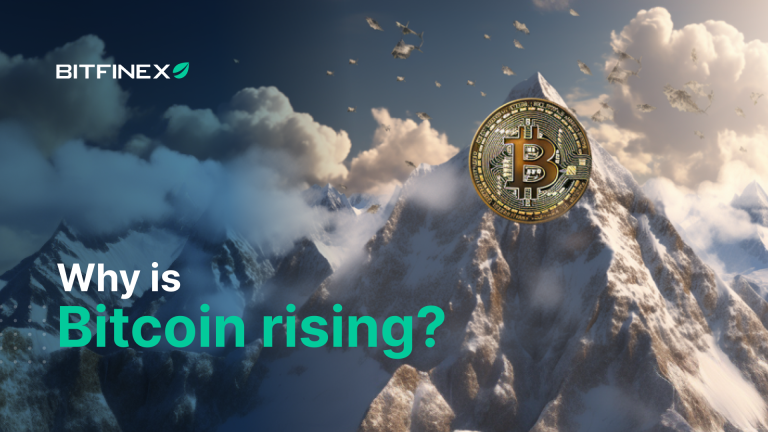05 March Why is Bitcoin rising?
in education
Recently, the launch of Bitcoin exchange-traded funds (ETFs) has made the cryptocurrency market more exciting, especially in Bitcoin trading. Notably, retail investors have been using these ETFs to participate in the rise in Bitcoin prices, which has led to the currency crossing the $60,000 mark for the first time since November 2021.
New Bitcoin ETFs appear to be seeing continued demand for Bitcoin
New Bitcoin ETFs such as iShares Bitcoin Trust (IBIT) and Fidelity Wise Origin Bitcoin Fund (FBTC) have seen higher-than-expected trading volumes, showing strong demand from those who want to participate in Bitcoin price movements through regulated financial products.
The sharp increase in trading of Bitcoin ETFs such as IBIT and FBTC is a testament to the strong interest of retail investors in investing in cryptocurrencies, thanks to the convenience and regulatory compliance of ETFs. With IBIT trading volume doubling from its previous high and FBTC also setting a new record, it is clear that these financial instruments are becoming the preferred choice for those looking to participate in Bitcoin price movements. The price volatility of ETFs, which are very similar to Bitcoin price funds, not only proves their effectiveness but also highlights the growing investor interest in cryptocurrency-related products.
The enthusiasm for Bitcoin ETFs and their contribution to Bitcoin's upward price pressure is also evident in the overall price increase of these funds. As the price of Bitcoin has risen nearly 30% since the ETF was approved, fund prices have also risen accordingly, creating strong bullish momentum this week.
While not all Bitcoin funds are following this rally, as evidenced by the ongoing withdrawals from Grayscale Bitcoin Trust (GBTC), as investors shift to cheaper funds to avoid higher GBTC costs, the overall mood remains positive towards Bitcoin. These funds not only expanded access to Bitcoin, but also added to the sharp upward pressure on prices by bringing new capital into the market, fueling Bitcoin's upward journey amid growing mainstream adoption.
The upcoming half-season is like adding fuel to the fire
The upcoming Bitcoin halving, scheduled for April, will increase the positive mood surrounding Bitcoin, adding another layer of excitement to the cryptocurrency market. A Bitcoin halving event halves the rewards for mining new blocks, reducing the rate at which new Bitcoins are created and brought into circulation. This helps control inflation, and history shows that such events often precede sharp increases in the price of Bitcoin. With broader Bitcoin adoption and institutional interest, the April halving event becomes important. Investors expect a slowdown in supply growth to lead to a sudden rise in Bitcoin's price, especially as more investors and institutions view it as a digital store of value.
Moreover, the halving is not just a technical event but also a psychological one, highlighting Bitcoin's value as an anti-inflationary asset. Amid global economic uncertainty and inflationary pressures in fiat currencies, Bitcoin's halving is a reminder of its scarcity and ability to reduce the risk of currency depreciation. This story reflects positive sentiment from individual and institutional investors, creating a positive mood and speculative demand ahead of the halving event.
During a “bear” market, construction continues to build
During the sale, the community witnesses innovation with the emergence of new technologies such as Ordinals, Stamps, BRC-20 tokens, and various Layer 2 protocols such as Lightning Network, Mercury Layer, Chaumian E-Cash, Liquid Network, and Rollups. These developments not only improve Bitcoin's usability and scalability, but also contribute significantly to the positive mood surrounding Bitcoin. By addressing a number of challenges such as transaction speed, cost and scalability, these technologies expand the potential uses of Bitcoin, transforming it from a store of value into a more flexible digital asset.
Ordinals and Stamps have introduced a new way to include data in Bitcoin transactions, allowing non-fungible tokens (NFTs) and other digital creations to be created directly on the Bitcoin blockchain. This opens new opportunities for artists, creators, and developers to explore Bitcoin as a platform for creating and owning digital assets, attracting a new audience to the Bitcoin ecosystem. The ability to create NFTs on the Bitcoin blockchain adds an additional layer of functionality and value to the network, strengthening its position in the competitive cryptocurrency market.
On the financial front, the introduction of the BRC-20 token could change the way Bitcoin is used by allowing the creation of token assets and smart contracts on the Bitcoin network. This move towards DeFi (decentralized finance) on the Bitcoin blockchain could unlock tremendous value, making Bitcoin a more attractive investment beyond its traditional role. Combined with layer 2 solutions like the Lightning Network, which makes transactions instantaneous and low-cost, Bitcoin is becoming more accessible and practical for everyday transactions and micropayments, increasing its appeal and use cases.
Furthermore, Layer 2 protocols like Lightning Network, Mercury Layer, and Chaumian E-Cash like Cashu, Fedimint, Liquid Network, and Rollups directly address Bitcoin's scalability challenges. By enabling faster, more efficient transactions and expanding Bitcoin's capabilities, these protocols lay the foundation for a robust and scalable blockchain infrastructure. The promise of increased privacy, increased ability to process transactions, and lower fees makes Bitcoin a more attractive option for both users and developers. As these technologies continue to evolve and are adopted, they will likely stimulate more innovation and investment in the Bitcoin ecosystem, enhancing positive sentiment and vision for the future of Bitcoin.
future prospects
In short, the launch of the ETF is only part of Bitcoin's bullish story. The upcoming Bitcoin halving event in April, which represents scarcity of the asset, is also creating demand. While open source creators and advocates provide the foundation for increasing the utility and value of Bitcoin, the full value of Bitcoin remains elusive.

